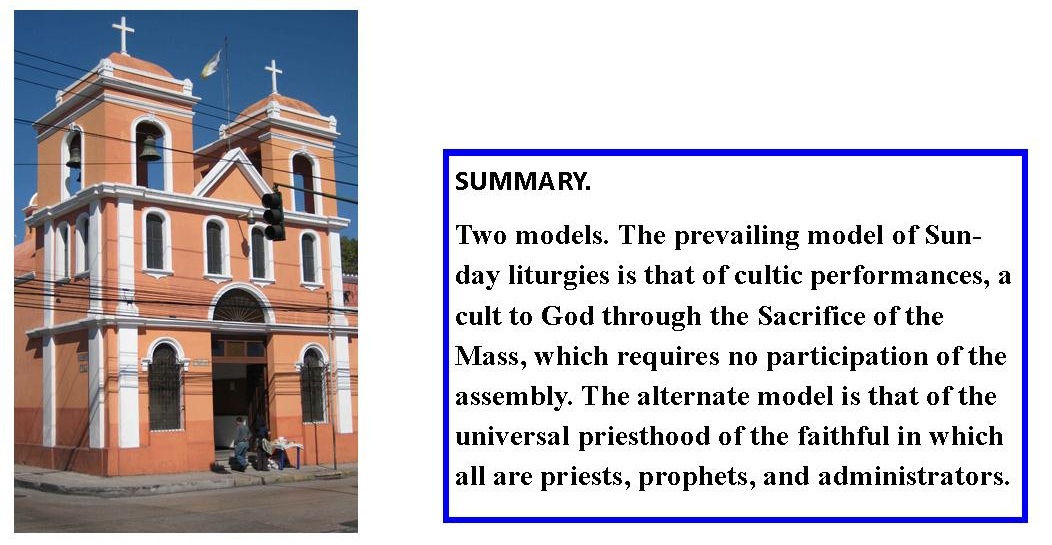
VISITING 100 CHURCHES
7. Two Models of Worship
|
This post presents a general conclusion The most prevalent model of worship in the 100 churches I have visited is one of cultic worship, but this term may be misleading. In English, “cult” usually refers to deviant forms of worship (the sociological meaning), but not in French and Spanish which retain the traditional meaning of the Latin cultum. Both the Catholic and the Protestant cults are said to be practiced in France, besides the Jewish cult; in Guatemala, traditional Masses are usually referred to as cultic. In traditional Catholic theology, worship is defined as a cult of latria, while the veneration of the saints is a cult of dulia. A cult – in antiquity and ancient Judaism – is the offering of a sacrifice by a priest; it involves three elements, the priest, the victim, and the offering ritual, but no attendance is required. In traditional theology, the Mass is understood as the sacrifice of the cross offered sacramentally, and no attendance is required besides an altar server. A Saturday evening Mass in front of an empty church has no different value than a Sunday morning Mass with many liturgical ministers. Attendance and active participation of the faithful are desirable, but not necessary, even by canon law standards (see canon 1248). This has enormous consequences: imagine a school where attendance is only desirable, not mandatory; this school would be empty most of the time. What can be done to increase participation? In the present perspective, not much, but in a different perspective, a lot. The American bishops have defined ecclesial ministers as ecclesiastical helpers. Here are their examples (in Co-workers in the Vineyard, page 9): extraordinary Eucharistic ministers, readers, choir members, catechists, pastoral council members, visitors to the sick, youth ministers, and workers for charity and justice. All these co-workers need approval from the bishop or the pastor and certification. In short, ecclesial ministers are helpers of the institutional church and the bishops leave no room for others forms of ministry. The problem with this perspective is that the parish needs only a limited number of Eucharistic ministers, choir members, youth ministers, and catechists, hence beyond a given number it cannot involve more ministers. This view is based on an unequal theology of the church: priests have a vocation and are ordained; lay people have no special vocation and cannot be ordained, hence have little incentives to get involved in typically church matters. There is a different perspective: the universal priesthood in which all are called to serve according to their special talents and vocation. Theologians, Catholic school educators, and nurses in Catholic hospitals obviously have a special mission, but their vocations are not recognized in the institutional church. Moreover, it is all educators and nurses that have special missions and vocations, not only those working in Catholic settings. All Christians have a special mission in family and society, a teaching that is strongly emphasized in many evangelical churches; it is something Catholics have to discover. The Latin American bishops meeting in Aparecida in 1997 have developed such a new vision. The title and program of Aparecida is “Disciples and Missionaries of Jesus-Christ.” The first part is entitled, “The life of our Peoples Today;” it refers to the Latin American peoples without the traditional dichotomy of the ordained versus the non-ordained. The second part, “The Life of Jesus Christ in the Missionary Disciples,” refers to an implicit theology of incarnation, not a spirituality of salvation through suffering. Part three, “The Life of Jesus Christ for Our Peoples” is a missionary invitation to look ad extra without distinction of rank, not ad intra. The word Eucharist is used in preference to Mass; it can be understood in reference to Benedict XVI’s inaugural address, “Every Sunday and every Eucharist is a personal encounter with Christ.” But the Eucharist as an encounter with Christ leaves no room for passive attendance and non-participation, as is the case in the Mass as a cultic performance. There can be no greater participation in the liturgy as long as the lay people are second class members who can only “attend” the priestly performances. But there will be increased participation in ritual when there will be greater participation in church life, not just ecclesial ministries. This requires a fresh discovery of the individual vocation of each participant, and this I have seen happening in Guatemala. When members are active participants in the life of their communities, the liturgy become the expression of their participation; then the liturgy becomes what it is supposed to be, the prayer of the people, rather than rituals and prayer translations prescribed from above. And this change can begin from below, and now.
QUESTIONS.
|